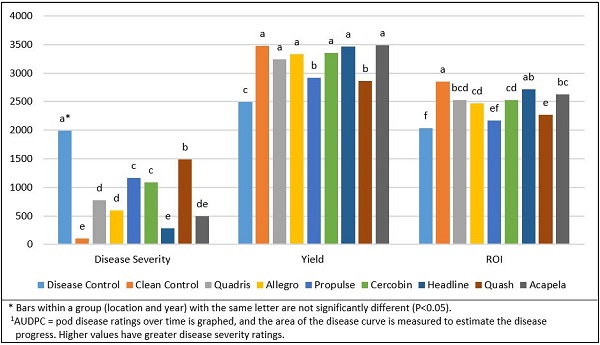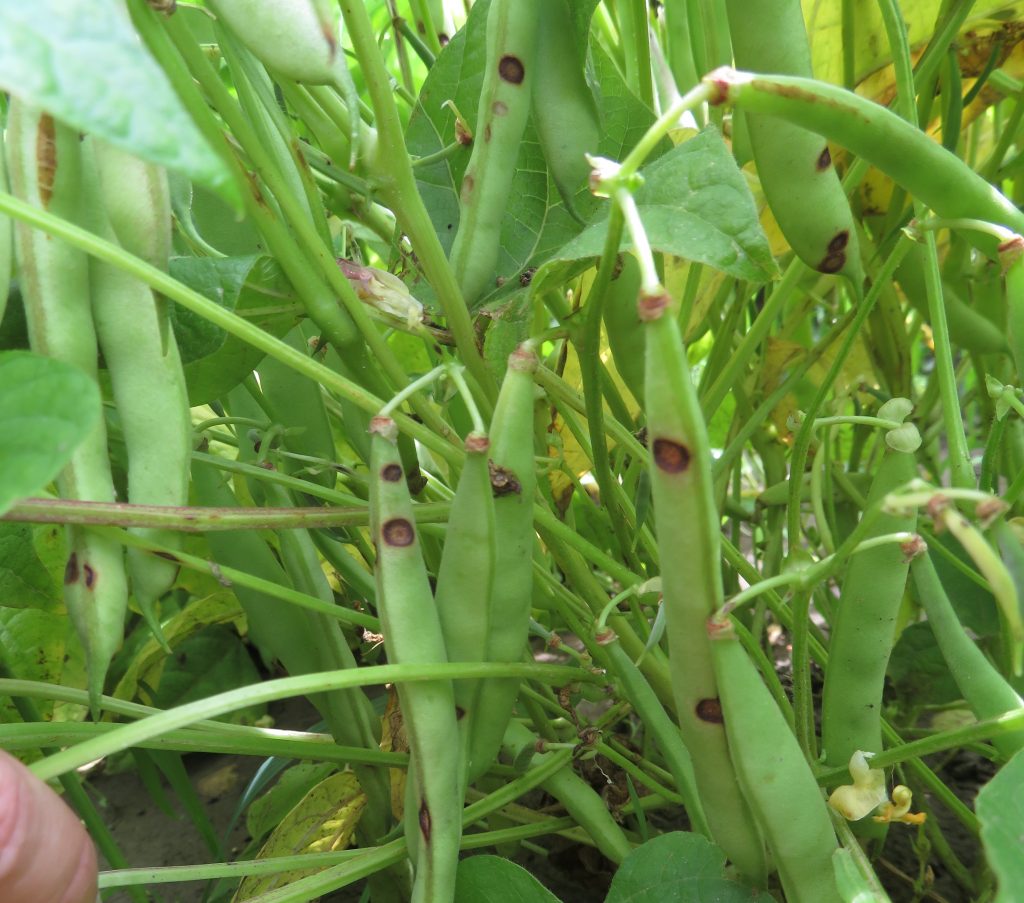Fongicides contre l’anthracnose dans les haricots secs
L’anthracnose peut causer de lourdes pertes de rendements et de graves problèmes de qualité des graines dans les haricots secs. On lutte contre l’anthracnose en partie en ayant recours à des cultivars résistants, par l’utilisation de semences exemptes de la maladie et par le traitement chimique des semences. L’utilisation de semences locales accroît les risques d’éclosion de la maladie, et les producteurs sont invités à utiliser des fongicides pour en atténuer les risques. L’objet de l’étude dont il est question ici était d’évaluer l’efficacité des traitements fongicides et les avantages économiques qui y sont associés, particulièrement dans le cas des fongicides homologués pour la lutte contre la pourriture à sclérotes (sclérotiniose) dans les haricots secs. Mais est-ce qu’un seul fongicide peut lutter à la fois contre la pourriture à sclérotes et l’anthracnose?
Au total, quatre petites parcelles expérimentales ont été utilisées pour l’essai à la Station de recherche Huron à Exeter, en Ontario, entre 2014-2018. L’infection initiale de la maladie a été provoquée par des semences infectées et un inoculum foliaire. L’irrigation sur frondaison a été utilisée pour favoriser la prolifération de la maladie. On a comparé sept fongicides à une parcelle témoin sans traitement. Un indice a été développé en vue de mesurer la gravité de la maladie avec le temps : plus l’indice augmentait plus la maladie s’intensifiait. Le rendement des graines (kg/ha) a été ajusté à 18 % d’humidité et le rendement sur investissement ($/ha) a été évalué en tenant compte du coût du fongicide comme tel et de son application, tous les autres coûts étant présumés égaux.
 Figure 1. Gravité de l’anthracnose (AUDPC1), rendement des haricots secs (kg/ha) et retour sur investissement ($/ha) à la Station de recherche Huron, 2014-2018.
Figure 1. Gravité de l’anthracnose (AUDPC1), rendement des haricots secs (kg/ha) et retour sur investissement ($/ha) à la Station de recherche Huron, 2014-2018.
L’utilisation de fongicides à base de strobilurines (Quadris, Headline, Acapela) a été associée à des taux de maladie plus faibles ainsi qu’à des rendements élevés et aux meilleurs revenus (figure 1). Acapela a également procuré une certaine maîtrise partielle de la pourriture à sclérotes. Dans la catégorie des fongicides contre la pourriture à sclérotes, Allegro a présenté la meilleure combinaison en matière de lutte contre l’anthracnose, de rendement et de retour sur investissement. Cercobin présentait un taux de maladie supérieur à Allegro, mais des rendements et un retour sur investissement semblables. Propulse présentait des résultats similaires à Cercobin en ce qui a trait aux maladies, mais les rendements qui y étaient associés étaient plus faibles et le retour sur investissement était aussi faible que pour la parcelle témoin. Quash (metconazole) s’est avéré peu efficace, a présenté un taux de gravité élevé, de faibles rendements et un médiocre retour sur investissement.
Pour plus d’information, voir DryBeanAgronomy.
Publié initialement dans Crop Protection 2020, volume 127, 104979.
~~~
Anthracnose can cause severe yield and seed quality issues in dry beans. Anthracnose is managed in part with genetic resistance, clean seed and chemical seed treatments. Locally grown seed increases the risk of a disease outbreak, and growers are encouraged to use fungicides to manage this risk. The purpose of the study was to measure fungicide performance and economic returns, with a focus on fungicides registered to control white mold in dry bean. Can one fungicide manage white mold and anthracnose?
A total of four small plot experiments were run at the Huron Research Station at Exeter Ontario between 2014-2018. Infected seed and a foliar inoculum were used to provide the initial disease infection. Overhead irrigation was used to promote disease growth. Seven fungicides were compared to an untreated control treatment. An index was developed to measure disease severity over time – as the index increased, disease increased. Seed yield (kg/ha) was adjusted to 18% moisture and return on investment ($/ha) accounted for the fungicide and application costs, with all other costs assumed to be the same.
The strobilurins (Quadris, Headline, Acapela) had low disease, high yields and the best economic returns (Figure 1). Acapela also provides some suppression of white mold. For the white mold products, Allegro had the best combination of anthracnose control, yield and ROI. Cercobin had more disease than Allegro, but similar yield and ROI. Propulse had similar disease to Cercobin, but lower yield and poor return on investment (ROI) – as low as the infected control. Quash (metconazole) was a poor treatment, with high disease severity, low yield and a poor ROI.
Originally published in Crop Protection 2020. Volume 127. 104979.
 Figure 1. Anthracnose disease severity (AUDPC1), dry bean yield (kg/ha) and return on investment ($/ha) at Huron Research Station, 2014-2018.
Figure 1. Anthracnose disease severity (AUDPC1), dry bean yield (kg/ha) and return on investment ($/ha) at Huron Research Station, 2014-2018.